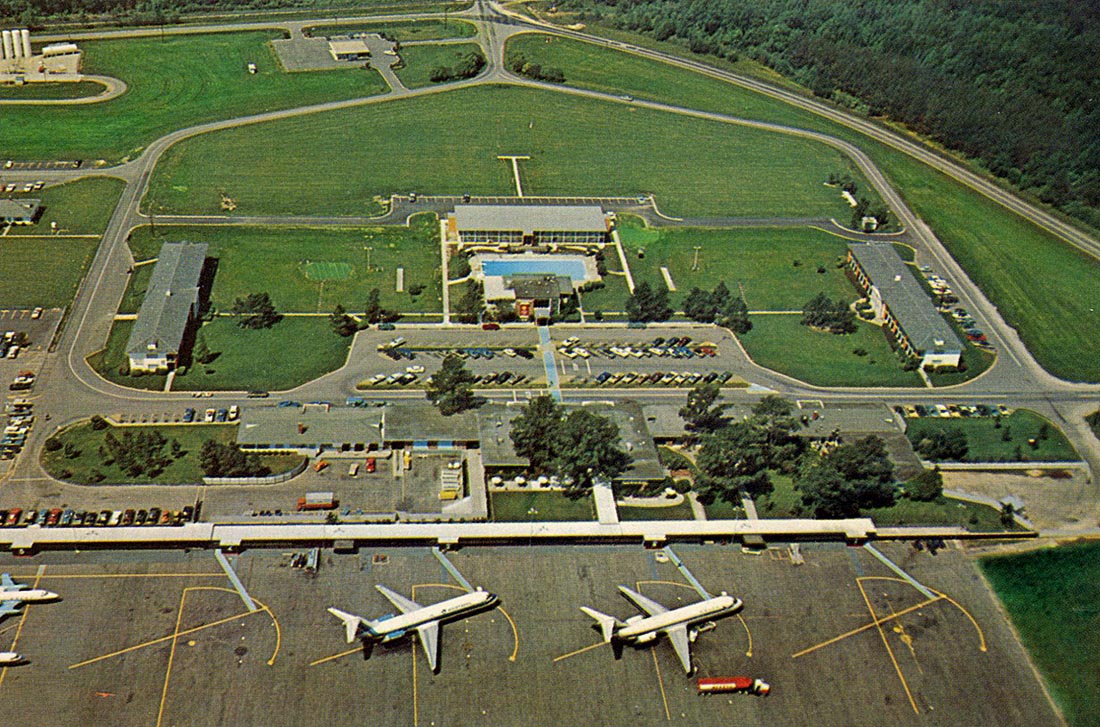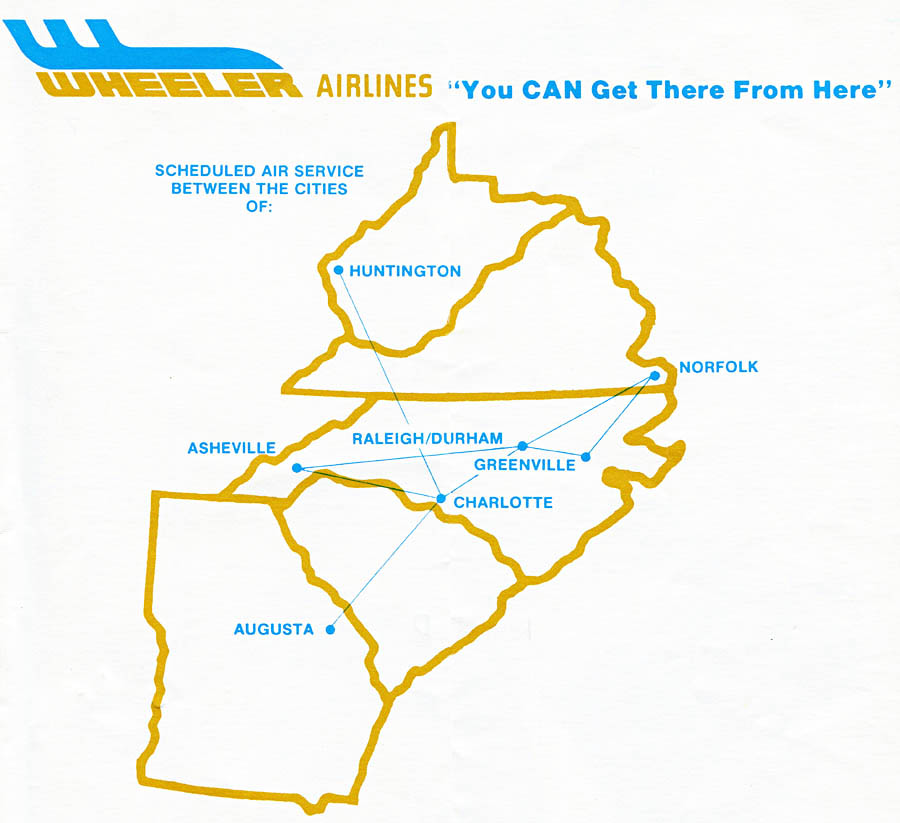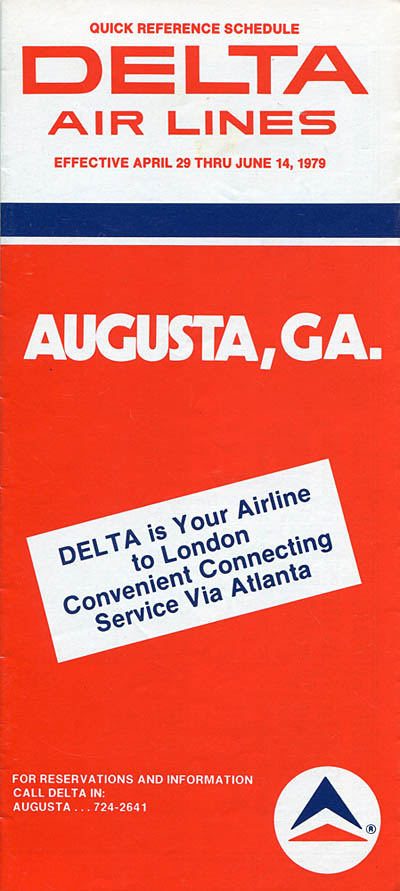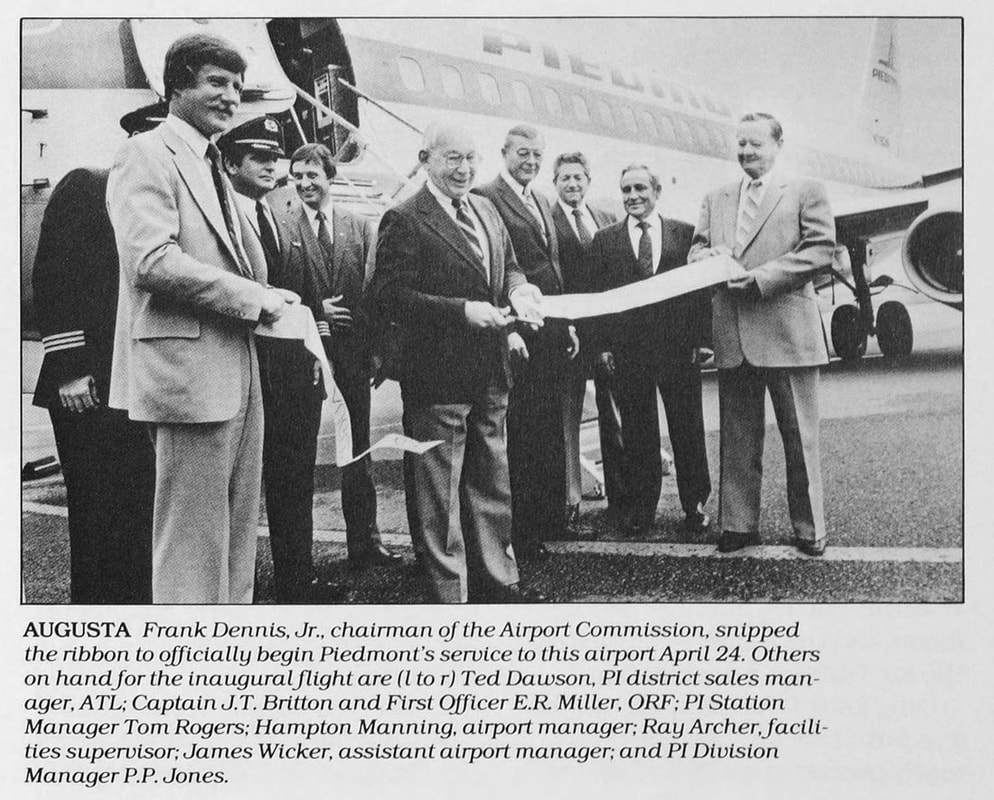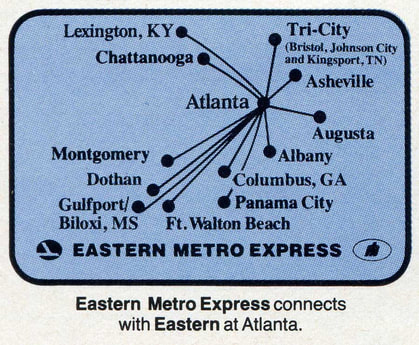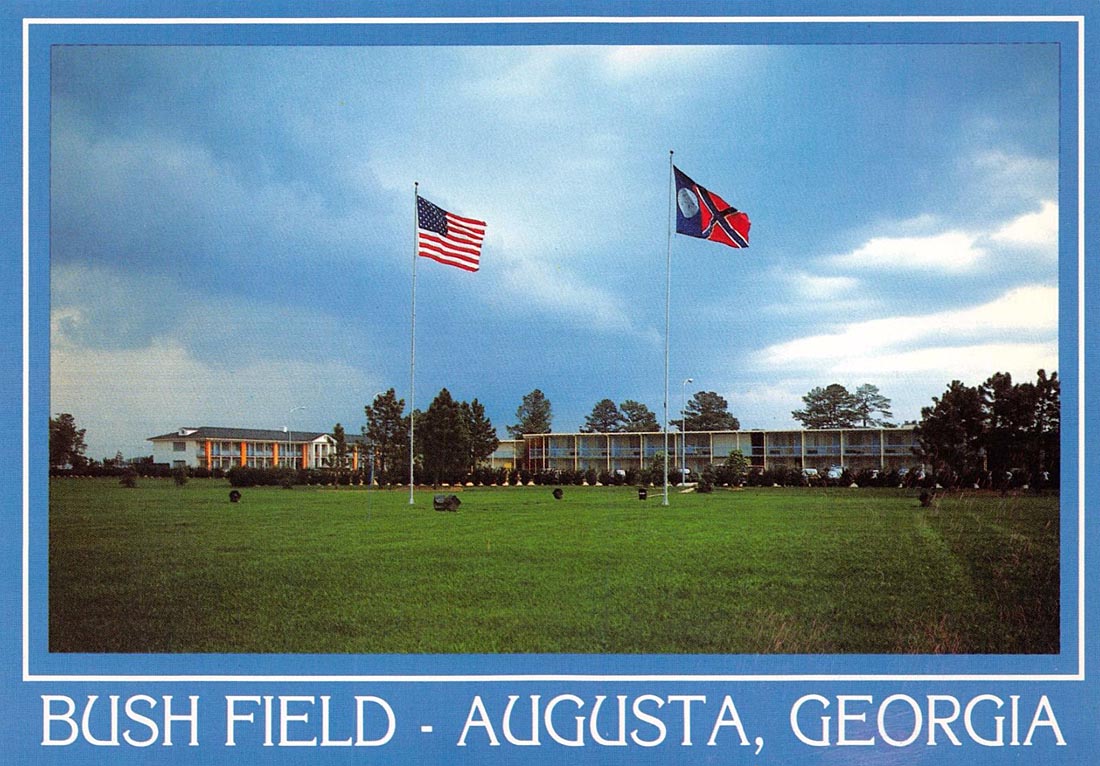HISTORY OF AIRLINE SERVICE AT AUGUSTA, GA
Part 2 : 1970s - 1980s
Postcard view of Augusta Bush Field circa 1973 showing DC-9s of Eastern and Delta Air Lines at the terminal. The Continental Airport Hotel is to the right.
The October 15, 1971 Official Airline Guide shows 31 arrivals from 8 cities on an average day at Augusta. The DC-9 was by far the most common aircraft type used along with Piedmont's turboprop YS-11s and a single Eastern 727-100 each day.
The Bush Field passenger terminal as seen from the entrance of the Continental Airport Hotel, August 8, 1973.
The airline gate waiting area was spacious and relaxed as seen in this August 8, 1973 press photo. This excerpt from the May 1, 1966 issue of the Piedmonitor describes the laid-back atmosphere of Bush Field: "Normally airports are busy places filled with hurried workers and travelers ready to go. Not so in Augusta. As Station Manager Dave Smith says, “people here don’t know how to rush.” It is an easily understandable situation. People may rush to get to Augusta, but no one is in a hurry to leave. "
Two circa 1976 postcard views of Bush Field once again showing Eastern and Delta DC-9s on the ramp. A new addition has been added next to the pool of the Continental Airport Hotel.
Eastern Air Lines discontinued service to Augusta in 1976. Within months, North Carolina based Wheeler Airlines began commuter service between Augusta and Charlotte using 15-seat Beech 99s. Wheeler's April 1, 1977 timetable shows 3 weekday round trips along the route. The service was not a success and Wheeler left Augusta in mid 1978.
With the passage of the Airline Deregulation Act on October 24, 1978, airlines quickly began to reallocate their resources to more profitable markets, generally dropping short routes to small and medium size towns in favor of longer and more profitable routes between major cities. Piedmont was no exception to the trend and suspended service to Augusta on March 1, 1979.
The May 1979 issue of the Piedmonitor employee newsletter summed it up this way: "Another aspect of deregulation, of course, is the flexibility to get out of some cities that don’t really make sense for our system. During recent months we have applied for suspension at ten cities, the result of an agonizing reappraisal of our route structure. Over the years Piedmont, perhaps more than most airlines, has resolved marginal questions in favor of the small city, in recognition of the loyalty those small cities have shown to Piedmont. The coming of deregulation, however, will mean a highly competitive environment, and a need to carefully prune our route structure. As a result, we have sought and are in the process of obtaining suspension at ten cities [including] Augusta, Georgia."
The May 1979 issue of the Piedmonitor employee newsletter summed it up this way: "Another aspect of deregulation, of course, is the flexibility to get out of some cities that don’t really make sense for our system. During recent months we have applied for suspension at ten cities, the result of an agonizing reappraisal of our route structure. Over the years Piedmont, perhaps more than most airlines, has resolved marginal questions in favor of the small city, in recognition of the loyalty those small cities have shown to Piedmont. The coming of deregulation, however, will mean a highly competitive environment, and a need to carefully prune our route structure. As a result, we have sought and are in the process of obtaining suspension at ten cities [including] Augusta, Georgia."
Delta Air Lines Augusta city timetable effective April 29, 1979 through June 14, 1979 shows a total of thirteen daily departures: eight to Atlanta, two to Charleston, SC, one to Columbia, SC, and two to Savannah.
Following the departure of Eastern and Piedmont, Delta's traffic at Augusta increased to the point that the 4-engine, 199 passenger DC-8-61 was used on several flights a day. This itinerary from 1979 shows Delta's flight 956 operating the "stretch 8" on the Atlanta - Augusta - Charleston,SC route. (For those unfamiliar with these codes, D8S is the DC-8-61, F is first class, Y is coach, ATL is Atlanta, AGS is Augusta, and CHS is Charleston.) During the Masters Tournaments in the 1980s and 1990s, 302-seat Lockheed L-1011 Tristars were commonplace on the Augusta - Atlanta runs.
In July 1980 Atlantis Airlines was the next commuter carrier to try its luck at the Augusta - Charlotte route which had been abandoned by Eastern Air Lines in 1976. The July 15, 1980 timetable shows two daily round-trips between the cities. Air Carolina also flew this route for a few months in 1980.
Atlantic Southeast Airlines began service between Augusta and Atlanta in 1983 using 48-seat DeHevilland Dash 7 turboprops. Within months, Atlantis Airlines was also flying the route.
ASA's May 15, 1983 timetable shows two round-trips between ATL and AGS flown with Dash 7 equipment.
One the major effects of airline deregulation is that airlines abandoned their historic point-to-point, multi-stop route networks in favor of concentrated hub-and-spoke systems which funneled traffic through large connecting hubs. Piedmont returned to Augusta on April 24, 1983 with 737 service to their major hub at Charlotte.
By the mid 1980s, almost every major airline in the U.S. had formed codeshare alliances with commuter carriers in which the smaller airlines would feed traffic into the major airline's hubs using a shared name, identity and airline code. Eastern's December 15, 1985 timetable shows Eastern Metro Express commuter flights between Augusta and Atlanta while Eastern Atlantis Express connected Augusta with Charlotte.
This excerpt from the 1985 edition of Airport Activity Statistics shows that Delta operated nearly every type of aircraft in their fleet at Augusta during the year. DC-9s, 737s and 727s handled the majority of flight schedules while larger 757s, DC-8-71s and widebody L-1011s were presumably brought in to handle peak traffic during the Masters Golf Tournament. Delta operated 2560 flights at AGS in 1985.
CCAir "Carolina Commuter" operated flights between Augusta and Charlotte during the late 1980s as Piedmont Commuter using Shorts 360s and Jetsream 31s while Piedmont maintained 737 and F-28 jet service. This map is from Piedmont's March 2, 1989 timetable. Piedmont was merged into USAir in August 1989.
At the end of the 1980s, 5 airlines were operating a total of 25 flights to 4 destinations from Augusta: Delta with DC-9 flights to Atlanta, ASA operating as Delta Connection with Embraer Brasilias to Atlanta, Eastern Express with Jetstream 31s to Atlanta, Columbia and Florence, SC, USAir with F-28 jets to Charlotte and USAir Express with Shorts 360s to Charlotte.





